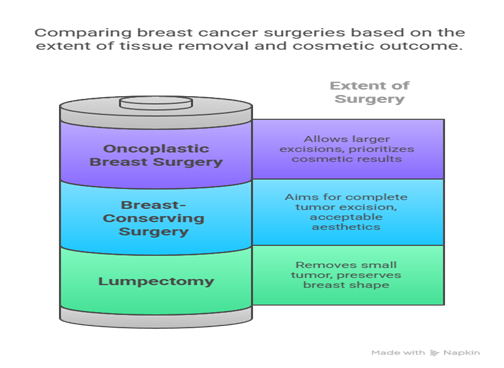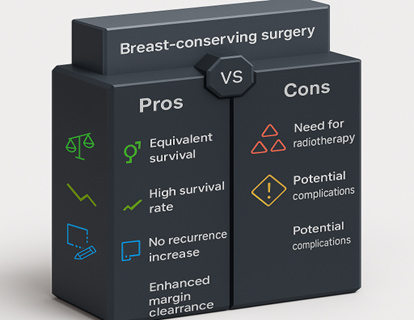Article: Breast-Conserving Surgery in Cancer Patients
M3 India Newsdesk Apr 28, 2025
This article synthesises data from contemporary clinical trials, meta-analyses, and Indian cohort studies to provide a comprehensive understanding of patient selection, surgical techniques, neoadjuvant approaches, and treatment-related outcomes.

Breast-conserving surgery (BCS), followed by radiotherapy, has emerged as a standard of care for early-stage breast cancer, offering survival outcomes comparable to mastectomy while preserving body image and quality of life [1,4,8]. Despite this, its adoption remains inconsistent, particularly in low- and middle-income settings like India, where mastectomy continues to dominate due to late-stage presentations, inadequate infrastructure, and sociocultural factors [9,11,12,13].
Oncoplastic breast surgery (OPBCS) has expanded the scope of BCS by enabling wider excisions with superior cosmetic outcomes without compromising oncological safety [5,6,7].
The review underscores the need for multidisciplinary decision-making, surgeon training, and healthcare equity to optimise the application of BCS in diverse global contexts. Special attention is given to triple-negative disease, rural access disparities, and evolving paradigms in radiotherapy omission [2,3,8,10,14].
Breast-Conserving Surgery
The surgical management of breast cancer has undergone a transformative shift from radical mastectomy to organ-preserving strategies, largely driven by evidence supporting the oncological equivalence of breast-conserving surgery (BCS) with radiotherapy compared to mastectomy [1,4]. This evolution reflects not only technological advancements and improved understanding of tumour biology but also a growing emphasis on patient-centric outcomes such as body image and psychosocial well-being [7,12].
International trials like the PRIME II study have demonstrated the safety of omitting radiotherapy in selected low-risk cohorts, further redefining surgical paradigms [1]. However, in resource-constrained settings like India, the uptake of BCS remains low due to late-stage presentation, infrastructural limitations, and variability in surgeon training [9,10,11,13].
The emergence of oncoplastic breast surgery (OPBCS) has further extended the indications of BCS, even in complex cases, combining oncologic safety with aesthetic refinement [5,6]. This review integrates global and Indian data to critically examine current approaches and outcomes of BCS.
Patient Selection and Evaluation
Optimal selection for breast-conserving surgery (BCS) relies on a nuanced evaluation of tumour characteristics, patient comorbidities, and institutional capabilities. Classical criteria include unifocal tumours ≤5 cm, absence of extensive microcalcifications, and feasibility of achieving negative margins with satisfactory cosmetic outcomes [2,3].
However, selection is increasingly individualised, with gene expression profiles and MRI being leveraged to identify candidates even in complex scenarios [13,14]. The role of a multidisciplinary tumour board is pivotal in integrating surgical, radiological, and oncological insights for personalised decision-making [14].
In the Indian context, BCS eligibility is often overridden by systemic barriers. A large real-world study involving 3453 Indian women showed that despite a significant proportion presenting with early-stage disease, mastectomy was disproportionately chosen, driven by surgeon preference, lack of radiotherapy access, and patient misconceptions [10,11].
Moreover, rural-urban disparities and limited patient involvement in surgical decisions further narrow the window for BCS implementation [9,11,12]. Expanding surgeon training and decentralising radiotherapy are critical for equitable patient selection.
Surgical Techniques
- Breast-conserving surgery (BCS) encompasses standard lumpectomy and quadrantectomy techniques aimed at complete tumour excision with cosmetically acceptable outcomes.
- Margin status remains a critical determinant of recurrence, with the “no ink on tumour” principle being widely accepted as adequate for invasive disease [3].
- Axillary management, typically via sentinel lymph node biopsy, complements BCS in staging and therapeutic planning [2].
- The advent of oncoplastic breast surgery (OPBCS) has significantly broadened BCS applicability, allowing larger excisions with immediate volume displacement or replacement techniques.
- A pooled analysis of 6941 patients demonstrated that OPBCS yielded superior cosmetic satisfaction and lower re-excision rates compared to conventional BCS, without compromising local control or survival [6].
- Notably, OPBCS is particularly advantageous in tumours located in cosmetically sensitive zones or requiring substantial tissue removal [5,7].
- Despite these advancements, in India, OPBCS remains underutilised due to limited surgical expertise and a lack of dedicated training pathways [9,12].
- Incorporating structured oncoplastic modules into surgical curricula may bridge this gap.

Neoadjuvant Therapy and Breast Conservation
Neoadjuvant chemotherapy (NACT) has revolutionised breast conservation by downstaging tumours previously considered inoperable. In Indian cohorts, NACT enabled BCS in a substantial subset of patients with locally advanced breast cancer [10,14]. Response-guided surgical planning, particularly in HER2-positive and triple-negative subtypes, has been shown to improve BCS rates while maintaining oncological safety [8,14]. Imaging and clip placement post-NACT are critical for accurate resection.
Adjuvant Therapy Considerations
Radiotherapy remains integral to BCS, significantly reducing local recurrence risk [1,4]. However, recent trials like PRIME II suggest omission may be safe in select low-risk older women, sparing toxicity without affecting survival [1]. In India, radiotherapy availability is a limiting factor; only a fraction of rural patients have access, directly influencing surgical choice [9,12,13]. Integration with systemic therapy should be individualised per tumour biology.
Oncological Outcomes
Multiple randomised trials and long-term cohort studies confirm that BCS with radiotherapy achieves survival outcomes equivalent to mastectomy [1,4]. In Indian data, 5-year overall survival exceeded 90% in early-stage cases undergoing upfront surgery [10]. OPBCS shows no increase in local recurrence and may offer enhanced margin clearance in difficult tumour locations [6].

Aesthetic Outcomes and Quality of Life
OPBCS consistently outperforms conventional BCS in cosmetic satisfaction, breast symmetry, and body image scores [5,6,7]. Patient-reported outcomes indicate lower distress, better sexual functioning, and improved psychosocial health with breast preservation [11]. Despite this, aesthetic outcomes remain underprioritised in India due to a lack of awareness and insufficient focus on patient-centred decision-making [9,12].
Challenging Scenarios
Multifocal tumours, hereditary syndromes, and locally advanced presentations have traditionally favoured mastectomy. However, with advances in NACT and OPBCS, many such cases can now be managed conservatively [8,10,14]. In elderly or comorbid patients, omission of axillary surgery and radiotherapy may be reasonable [1,13], requiring personalised decision-making through a multidisciplinary framework.
Take-Home Message
Breast-conserving surgery, especially when combined with oncoplastic techniques, offers oncological safety, aesthetic advantages, and improved quality of life. Despite strong global evidence, its adoption in India remains suboptimal due to infrastructure gaps, surgeon training deficits, and limited patient involvement [9,10,12]. Addressing these barriers through capacity building, equitable radiotherapy access, and multidisciplinary care is vital. As surgical paradigms shift toward personalisation and de-escalation, BCS stands central to future-ready, patient-centred breast cancer management [1,6,13,14].
Disclaimer- The views and opinions expressed in this article are those of the author and do not necessarily reflect the official policy or position of M3 India.
About the author of this article: Dr Alpa Modi, MS(Gen Surg), is a practising surgeon and onco-surgeon from Thane.
-
Exclusive Write-ups & Webinars by KOLs
-
Daily Quiz by specialty
-
Paid Market Research Surveys
-
Case discussions, News & Journals' summaries